Green industry
Green industry in Portland and Oregon
NOTE Utility-scale, alternative power in Oregon and Portland, solar and wind energy providers, and green building leadership in Portland are overviewed here, but many smaller "green" or sustainable-focused firms have not (yet) been listed or described. Wikipedia has a comprehensive Energy Section for more information.
Introduction
Oregon and Portland is becoming a green energy hub, [1][2] with utility scale energy generation using Wind, Solar and Wave, investments in electric car charging infrastructure, batteries and inverter technology, and a green building hub providing leadership nationwide.
Sustainable Utility Power in Oregon
Oregon's legislature passed a law in 2007 that requires utilities to get at least 25 percent of Oregon's power from renewable sources by 2025.[3] For 10 years beginning March 2002, through Oregon's Renewable Resource Programs[4], Portland General Electric (PGE) and Pacific Power customers pay a 3 percent charge on their monthly bills for conservation and renewable resource programs under Oregon's electric industry restructuring law. About 17 percent of the funds, estimated at $10 million to $13 million per year, are for projects that generate electricity from renewable resources. The Energy Trust of Oregon[5] administers the funds. Its goal for renewable resources is that they supply 10 percent of the state's electricity needs by 2012, an eight-fold increase.That goal has been largely attained.
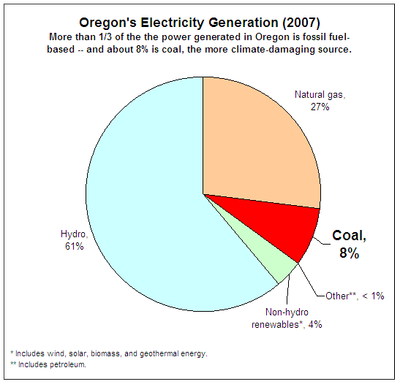
The U.S. is on a trajectory to generate 20% of the nation’s electricity from wind energy by 2030.[6] Wind and solar can (potentially) be cheaper than hydro, nukes or coal,[7] but renewables have more variables (like sun and wind) and can't store power (like a dam), or deliver on-demand power (like fossil fuel, hydro or nuclear). The U.S. spends about $1 billion a day importing oil, which is now over $100 a barrel[8], according to Energy Secretary Steven Chu[9]. The Advanced Research Projects Agency-Energy (ARPA-E) is funding breakthrough research in clean-energy technologies.
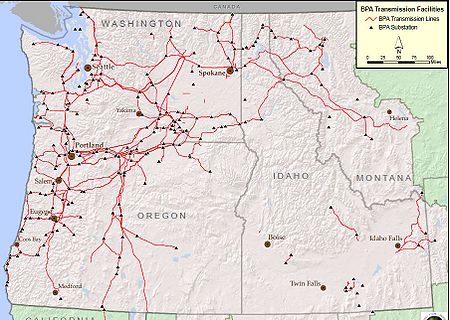
BPA owns and operates approximately 75 percent of the high voltage transmission lines in the Pacific Northwest maps.
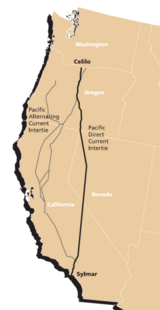
Power companies are provided with incentives by the federal government to get off dirty coal, often used to generate electricity, or natural gas, which is a limited resource. Dams are excellent power generators, but the Columbia River is nearly tapped out. Fishing issues and river transportation are also problematic.
The Dalles Dam[10], constructed by the federal government in 1957, is one of the largest "renewable" energy sources. It produces close to 1,800 megawatts of hydro power. The Grand Coulee Dam[11] is the largest electric power-producing facility in the United States and fifth largest producer of hydroelectricity in the world (2008), producing 6.8 Megawatts.
The Pacific DC Intertie[12], on Bonneville's grid[13], connects to Los Angeles with a line capacity of 3,100 megawatts.
The Northwest Power Act of 1980 called on the Northwest to give energy conservation top priority, since a megawatt saved is the equivalent of a megawatt produced. The Bonneville Power Administration is now launching their Post-2011 Energy Efficiency program.
Reducing dependency on foreign oil is a major thrust. Attracting innovative new businesses with growth potential and good jobs is another motivator.
The Federal Department of Energy, the State of Oregon and Portland aim to provide leadership in "green energy" and become a hub for sustainable innovations. Oregon is an energy exporter, tied into the grid through Bonneville. We also have lots of wind in the Gorge, Pacific Ocean waves, semi-conductor expertise for solar, and lots of scrap wood for cellulosic ethanol fuel.
Projected Growth of Green Economy
The main renewable energy industries grew 35% last year[14], and revenues should double again this decade, according to the Clean Energy Trends[15], a research and advisory firm based in Portland.
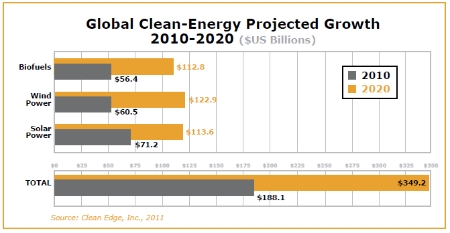
The Oregon Global Warming Commission was created by the 2007 Legislature. Keep Oregon Cool, is their website.
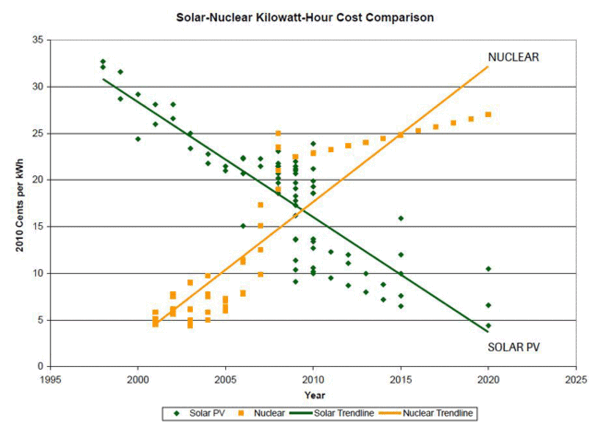
Grid parity[16] is when renewable energy costs are equivalent to non-renewables such as coal or oil. Grid Parity has been reached in Hawaii, where electricity costs around $.30 per Kilowatt hour (it's less then $.10 in Oregon). Most of the US is expected to reach grid parity by 2015, says Wikipedia. Gas will go up as renewables come down.
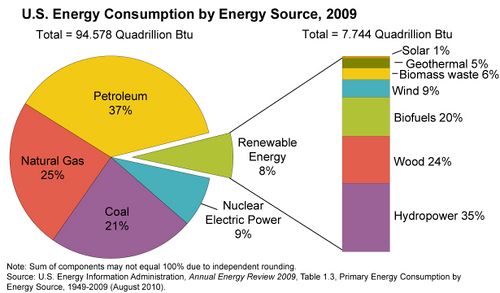
A low-carbon economy[17] is generally regarded as essential for maintaining life as we know it. The goal: Zero carbon emissions globally by 2050 [18]. It's a huge challenge.
Wind Farms in Oregon
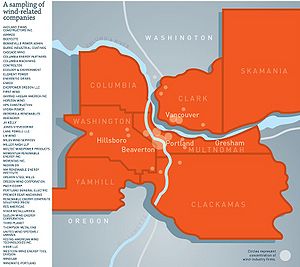
Wind power is one of the fastest growing forms of new electricity generation in the U.S., according to the American Wind Energy Association. In recent years, around 40% of all new generation capacity added to the electric grid in the U.S. was from wind power projects. A May 2008 Department of Energy study says wind power can provide 20% of the nation's electricity by 2030.
PGE[19], the state's largest utility, hopes to shut down the state's only coal-fired power plant 20 years earlier[20] than planned. PGE has natural gas and coal-fired power plants in Boardman and has proposed one or two additional natural gas plants there, if it closes its Boardman coal plant to meet haze-reduction rules or avoid carbon taxes[21]. The 585-megawatt coal fired plant[22] provides enough electricity to serve about 250,000 residential customers. The Vestas[23] V90 is a 3.0 MW wind turbine, so over 200 would be required to produce similar power. But only when the wind is blowing.
About 4 percent of PGE's energy comes from wind farms[24] — mostly the Biglow Canyon Wind Farm[25], plus power PGE purchases on contract from the Klondike II[26] and Vansycle Ridge[27] wind farms. The Stateline Wind Farm[28] runs along the Columbia River[29].
- Portland General Electric’s Biglow Canyon Wind Farm[30] is the second-largest wind energy facility in the state. Biglow's 141 Vestas wind turbines[31] produce 275 megawatts of power. The wind farm is located in Wasco County[32], near The Dallas, an area likely to get further wind development, despite growing community concern about noise and environmental impacts. The $1 billion project was completed in September, 2010[33]. Vestas[34], the largest wind turbine manufacturer, has its North American headquarters in Portland. Here's a video tour[35] of a Vestas tower at Biglow[36] and Sam Churchill's Flickr photo collection[37] of Bigelow (below).
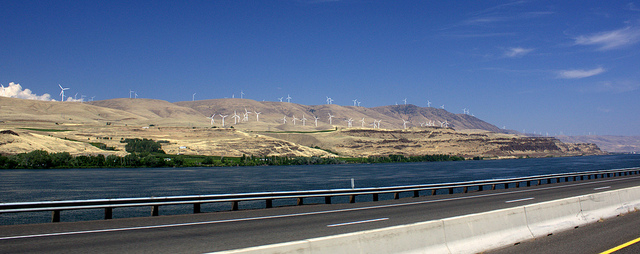
- Shepherds Flat Wind Farm[38], the world's largest, received a $1.3 billion loan from the DOE and will employ 400 workers during construction and 35 workers during operation. The 845 megawatt wind farm near Arlington, Oregon, will begin installation of the wind turbines in 2011 and is expected to be fully built in 2012. Built by Caithness Energy[39], it will supply electricity to Southern California Edison[40]. The wind farm, expected to be the largest land-based wind farm in the world when it is completed, will use 338 General Electric wind turbine, each generating up to 2.5-MW, their largest contract ever.
- In December, 2010, The U.S. Department of Energy finalized a $1.3 billion loan guarantee for the Shepherds Flat wind farm[41]. The power generated by the farm will be sold directly to Southern California Edison through 20-year fixed price power purchase agreements. Construction of the Shepherds Flat Wind Farm is expected to create 400 jobs, with 35 permanent jobs supported on site once its created.
- Eastern Oregon wind farms, especially the Summit Ridge wind farm in Wasco County, have now been thrown into doubt[42]. In September, 2010, the U.S. Fish and Wildlife Service recommended that the Oregon Department of Energy allow wind turbines no closer than 6 miles to a golden eagle nest. That has also prompted Portland General Electric to back off its push to buy development rights for a massive new wind farm near Arlington in Gilliam County.
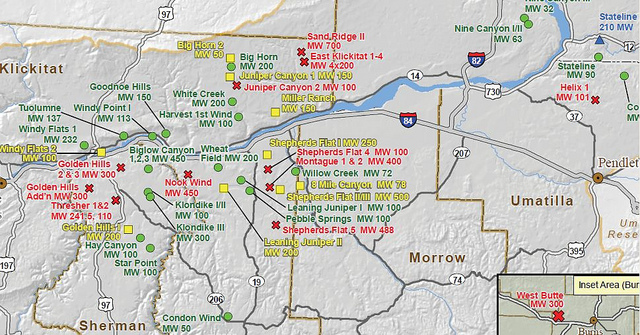
Iberdrola Renewables[43], headquartered in Portland, Oregon, is the second largest provider[44] of wind in the country has 41 wind farms in the United States with an installed capacity of 3,877 megwatts[45], enough to power close to 1 million average U.S. households. Klondike Wind Power[46], a subsidiary of Iberdrola Renewables, sells power to the Bonneville Power Administration[47]. Iberdrola's National Control Center in Portland receives data from approximately 800,000 sensors that monitor, weather, power generation and security at Iberdrola facilities around the country.
A SCADA system, supplied by PcVue relays wind speed, wind direction, shaft rotation speed and other data on every wind turbine.
Sales of small wind turbines[48] (100 kilowatts and less) in the U.S. grew from 2,100 units in 2001 to 9,800 units in 2009 (peak has been 10,386 in 2008), according to the American Wind Energy Association[49]. Electrical power is relatively cheap in Oregon (7 cents a kilowatt hour, compared to 29 cents in Hawaii) so often Oregonians who buy small wind turbines, especially for homes, aren't trying to save money but rather to invest in renewable energy and/or attain some energy independence.
Xzeres[50], a small-wind turbine manufacturer, is in Wilsonville. Oregon Wind's small vertical Helyx[51] is designed and manufactured in Portland, using locally sourced recycled materials.

As of November 2010[52], the two largest wind farms are in Texas; the 781.5 MW Roscoe Wind Farm[53] is the largest in the world, followed by the Horse Hollow Wind Energy Center[54] at 735.5 MW. The largest wind farm under construction is the 800 MW Alta Wind Energy Center[55] in California. The largest proposed project is the 10,000 MW Gansu Wind Farm[56] in China.
Solar Power in Oregon & Portland
The U.S. solar power industry grew 67 percent to $6 billion in 2010[57], up from $3.8 billion in 2009, according to the Solar Energy Industries Association[58].
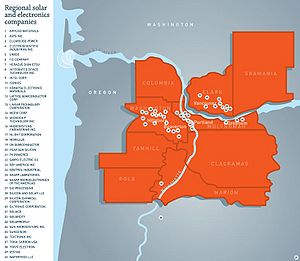
Crystalline silicon panels[59], like those made by industry leader SolarWorld in Hillsboro, Oregon[60], dominate 90% of the industry today[61]. Silicon prices have dropped recently, making traditional Monocrystalline silicon[62] more competitive, on a cost per watt basis, although competition from China is a constant worry.
The Portland region is positioning itself to be a production center for all three major photovoltaic technologies; Crystalline silicon[63], Cadmium Telluride[64] and Copper Indium Gallium Selenide[65].
- Monocrystalline is the most efficient, which makes it well matched for the limited area available on homes and businesses.
- Cadmium Telluride costs less, but is less efficient, so it's often used on utility scale projects with lots of real estate.
- Copper Indium Gallium Selenide is flexible, with medium efficiency and is often used in panels integrated with buildings or roofs.
Thin-film technology has proved challenging to commercialize[66], although both major thin film technologies; Cadmium telluride[67] and CIGS[68] seem posed to provide a more streamlined production process, lowering costs.
Cadmium telluride panel[69] manufacturers, like Solexant[70], in Greham, Oregon, claims they can manufacture solar panels for less than $1 per watt, while Startup CIGs developer SoloPower[71] is is said to be eyeing Wilsonville for a manufacturing plant[72].
Whether thin films will represent a huge shift in energy economics[73] remains to be seen.
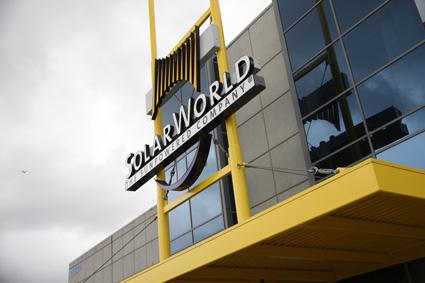
Some of the Photovoltaic players in the Portland region include:
- SolarWorld[74], the largest manufacturer of solar panels in the United States. The company unveiled its 210,000-square-foot addition[75] to its Hillsboro, Ore., manufacturing plant in 2010. It is now the only monocrystalline solar manufacturing plant in the United States to produce every phase of solar panel manufacturing. SolarWorld will collaborate develop a 11.6-megawatt solar system[76] with the LA Department of Water and Power, using more than 46,000 solar modules on the 42-acre site. SolarWorld has been supported partly by tax incentives from the city of Hillsboro, the state of Oregon and the US government via the Recovery Act. SolarWorld Group has its main manufacturing operations in Hillsboro and in Freiburg, Germany.
- SANYO Solar[77], claims to manufacturer the world’s most efficient solar panels, and has opened a monocrystalline growing facility in Salem, Ore[78]. The plant, spanning 130,000-square-feet at the Salem Renewable Energy and Technology Center and employing 200 highly skilled workers, represents an investment by SANYO of more than $84 million. Sanyo Solar grows crystals in Salem and slices them into wafers, which Japanese workers make into cells that go into panels in Japan, Hungary or Mexico.
- Cadmium Telluride developer Solexant[79], plans to build a $200 million solar manufacturing plant in Gresham[80]. The company plans to construct a 100,000-square-foot manufacturing plant that will initially employ 100 before growing to 170 at full production. Long term, the company hopes to eventually expand the facility to manufacture panels capable of generating 1,000 megawatts. Solexant's facility in Oregon[81], producing 100-megawatts of thin film CdTe[82] solar panels annually, will be the largest nanotechnology manufacturing facility in the world[83]. Long-term, the company hopes to expand the facility to 1000MW annually, reports Oregon Live[84]. Such a facility could employ as many as 1,000 workers.
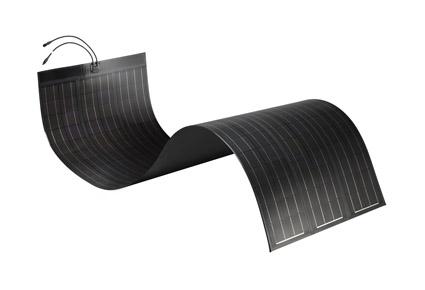
- CIGs developer SoloPower[85] is building a manufacturing plant in Wilsonville[86]. The $56 million manufacturing plant could employ 500 people within five years[87], says the company. SoloPower received a $197 million loan from the DOE, in February, 2011, to support construction of their Wilsonville plant. SoloPower's tough but flexible solar panels[88] are said to enable inexpensive roof mounting. Their expansion plans call for three more manufacturing lines[89], growing the plant’s capacity to 300 megawatts and its employment to around 500. SoloPower also sought and received a $20 million loan from the Oregon Energy Loan Program.
- Grape Solar[90] doesn't grow silicon crystals or make solar cells at its Eugene headquarters. Essentially, it just imports low-cost solar panels from China and re-sells them here[91].
Advanced Energy Systems[92] is the leading commercial solar integrator in Oregon, with commercial solar energy systems for Lewis and Clark College, ODOT, Kettle Foods, Pepsi-Cola, and other Oregon businesses.
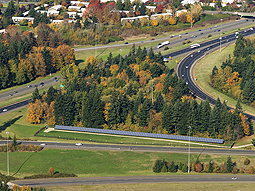
The nation’s first Solar Highway project[93] (right) started feeding electricity into Portland's electricity grid on Dec. 19, 2008. PGE’s “Oregon Solar Highway”[94] is a 100kW system that contains about 8,000 square feet of solar panels extending about the length of two football fields. It incorporates SolarWorld silicon PV array and the Solar Energy Grid Integration Systems[95] (SEGIS), a DOE program to develop photovoltaic (PV) systems that seamlessly integrate into the distribution and transmission grid. The site doesn't store electricity - it just sells "green power" back to PGE.
Urban solar systems - with lots of grid power available - often skip expensive and troublesome battery storage. Power companies, provided with incentives to get off dirty coal, are willing to buy wind and solar generated power.
The SuNRISE lab contains $1 million of state-of-the-art equipment to analyze solar cells[96] on the University of Oregon campus in Eugene. Solar is cheaper than nuclear energy[97], according to Duke University[98]. iSuppli predicts that around 13.6 GW of PV will be installed this year[99].
Microinverters[100] can be installed on each panel to eliminate the "Christmas light" effect, where shadow on one panel can kill a serial-connected string. With microinverters, each panel outputs 110 volts AC. If one panel is in shadow it does not effect the output of other panels. Enphase[101] has pioneered this technique and offers online monitoring of your installation[102] - here's a 4.81 kW solar array in Portland[103].
PV Powered[104], based in Bend, goes the opposite route, offering utility-scale inverters such as their 260kW, 97% efficient[105] commercial inverter.
Teanaway Solar Reserve[106] announced plans for a 75-megawatt plant made up of 400,000 photovoltaic panels[107], 4 miles North of Cle Elum, Washington[108], near Ellensburg.
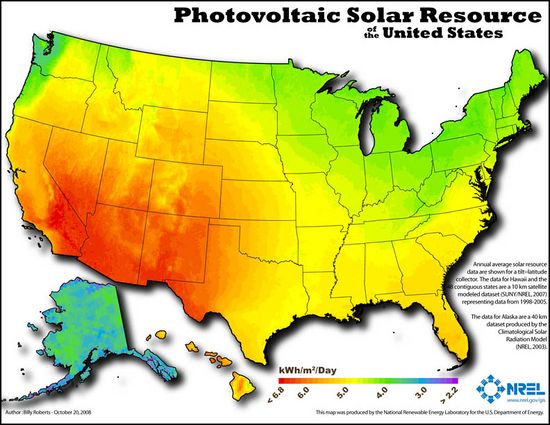
The National Renewable Energy Laboratory[109] has solar maps of the United States. Oregon may be a good place to make solar panels, but our sunshine pales compared to America's Southwest. According to three industry experts[110], though 13 percent of power generated in Oregon comes from wind and solar, solar makes up less than one percent of the mix, or less than one tenth of one percent of the state's total energy picture.
The DOE's SunShot Initiative aims to reduce the total costs of photovoltaic solar energy systems by about 75 percent by the end of the decade, so that they are cost-competitive with other forms of energy without subsidies. Right now solar costs as low as $1/watt to manufacture, but $4 installed. If it gets down to $1 per watt, it's comparable to or lower than other sources of generating electricity. A coal plant has an operational cost of $2.10 per watt.
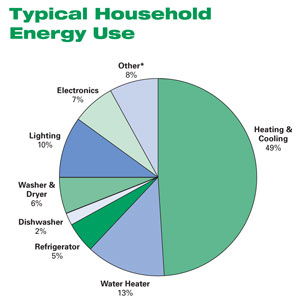
The Obama administration plans to fast-track utility-scale solar projects on BLM “solar energy zones” in six western states. But Oregon didn’t make the list[111], so any projects proposed on Bureau of Land Management land here – in southeast Oregon, for example – will have to go through a longer permitting process.
The largest solar power installation in the world[112] include the 48-MW Copper Mountain Solar Facility in Nevada[113], finished on Dec 1st, 2010, now the largest PV plant in the United States. More than 350 construction workers installed 775,000 First Solar panels that power the plant on the 380-acre site. Power from the Copper Mountain Solar Facility[114] (and the adjacent 10 MW El Dorado Solar Power Plant) has been sold to Pacific Gas & Electric under separate 20-year contracts. The completion of the project eclipsed the 20-MW DeSoto PV plant in Arcadia Florida, which was the previous record holder for the largest U.S. solar power plant.
NRG Energy[115] recently bought the 290-megawatt (MW) Agua Caliente solar project[116] in Arizona. The project, scheduled to be completed by 2014, is expected to be the largest operational photovoltaic (PV) site in the world. Agua Caliente will use First Solar thin-film panels. Solar thermal uses mirrors to boil water. It's being used to generate electricity in California, Nevada and elsewhere.
The Obama administration has approved a thousand-megawatt, $6 billion solar project in California[117] on federal land, spread over 7,000 acres. Solar panels, to be competitive without government subsidies, will have to cost $1 per watt says the DOE[118]. It's estimated the solar industry will get to $2 per watt within the next five years[119].
In Germany, the industry boomed after the Renewable Energy Act in 2000[120], which guarantees investors above-market fees for solar power for 20 years from the point of installation. Germany added 7 gigawatts (GW) of capacity in a record-breaking year in 2010 to bring the total to nearly 17 GW, equal to 17 large power plants.
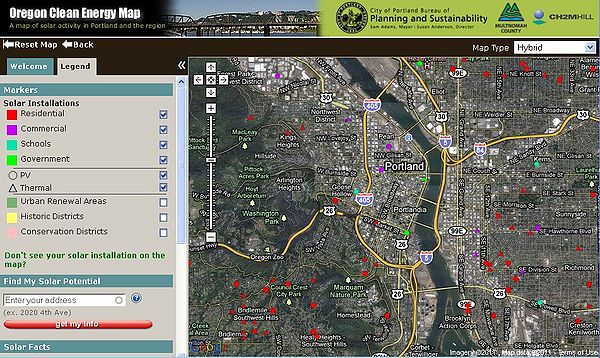
Portland's Office of Sustainability has created the Oregon Clean Energy Map showing solar information. The Office of Sustainability sponsors Clean Energy Works Portland, a Solar Energy Program, a Biofuels program and Solarize Portland, a solar panel volume-purchasing program.
Solar, like wind and hydro, is a long term investment with a significant front-end cost. A variety of financing instruments can make it profitable over ten years or so. Solar also enables individuals and businesses to take charge of their own destiny, bringing the grid home.
Wave Power
Wave Power[121] captures the horizontal and vertical movements of tides and waves to generate energy. Wave energy[122] can harness both ocean waves and strong sub-surface currents to generate electricity. One advantage of wave power is that, unlike sunshine or wind, it may have the potential to generate power, 24/7. The United States has committed $200 million in federal funds toward wave energy technology[123] , from 2008 through 2012.
The nation's first commercial wave-energy farm[124], designed by Ocean Power Technologies[125], is now underway off the Oregon coast. Once fully deployed, the $60 million system is expected to have a capacity of 1.5 megawatts[126] — about half that of a single giant wind turbine - though waves should produce power around the clock. Surfpower[127] and Renewable Energy Research have expressed an interest in exploring their options in Oregon[128] , according to Oregon Wave Energy Trust[129] .
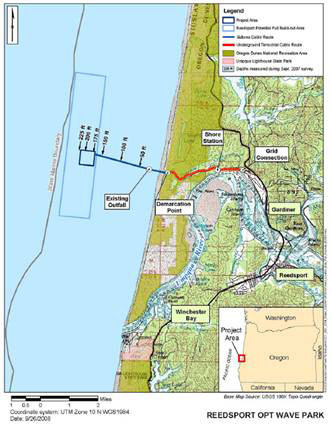
Ocean Power Technologies[130] is close to getting a license to build a wave energy plant off the coast of Oregon[131]. The New Jersey-based company has signed a settlement agreement that includes over 11 government agencies, and several private companies, to develop a 150 kW wave energy station[132] . When completed the plant will consist of 10 PowerBuoys that could generate enough electricity to power 1,000 homes annually, according to Ocean Power. A 10-Megawatt OPT power station[133] would occupy approximately 30 acres (0.125 square kilometers) of ocean space.
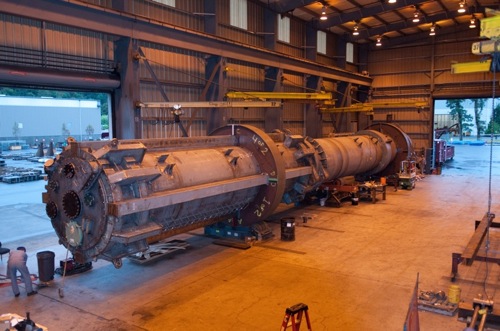
The first buoy will measure 150 feet tall by 40 feet wide, weigh 200 tons and cost $4 million. Nine more buoys are planned to deploy near Reedsport, Ore., by 2012, at a total cost of $60 million. Ocean Power Technologies has contracted with Oregon Iron Works[134] to build the buoys. Clusters of buoys would cover a five-mile stretch, north to south, less than three miles from shore.
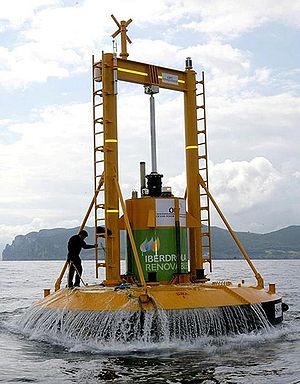
Columbia Power Technologies[135] has deployed an intermediate scale prototype near Seattle, controlled remotely from Corvallis. Columbia Power was founded in 2005 by Greenlight Energy Resources, in partnership with Oregon State University. Their design was the first ocean energy device to produce kilowatt scale electrical energy[136] off the Oregon coast. It will generate energy between one and three miles offshore[137].
Grays Harbor Ocean Energy[138] plans an offshore wave energy generation platform in shallow coastal waters 2.8 miles off of the Washington towns of Westport and Ocean Shores in Grays Harbor of Washington state.
Whether or not wave energy facilities should be sited inside the newly proposed marine reserves off the Oregon coast is currently a hotly debated topic[139] . The trick is to tap the benefits of a new industry without spoiling ocean habitats, economic livelihoods and recreational playgrounds[140] . Off shore energy policy[141] is still being worked out. No state agency in the U.S has ever permitted a wave energy project[142].
A wave-power device from another company, Finavera[143] , sank off the Oregon coast two years ago.
Other Oregon wave energy players include Aquamarine[144] , a Scottish company with a technology called The Oyster with an office in Newport, a Scandinavian company, Floating Power Plant, Norway’s Wave Energy A/S[145] in Tillamook looking at a jetty-based device, and a possible Texas-based[146] startup called Neptune Wave Power[147].
The Northwest National Marine Renewable Energy Center[148] is a partnership between OSU and UW. OSU focuses on wave energy. UW focuses on tidal energy[149]. Both universities collaborate with each other and the National Renewable Energy Laboratory[150].
Oregon Wave Energy Trust[151] is a nonprofit public-private partnership funded by the Oregon Innovation Council.
Pacific Energy Ventures[152] (Portland, Oregon) will build a Protocol Framework for identifying, collecting and comparing environmental data relevant to offshore renewable energy projects Oregon Wave Trust[153] is designed to serve as a connector for all stakeholders involved in wave energy project development.
Questions Over Subsidies
The huge Shepherds Flat wind farm raises big questions about state, federal subsidies[154], reported the Oregonian in a three part investigative report, beginning on Mar 13, 2011.
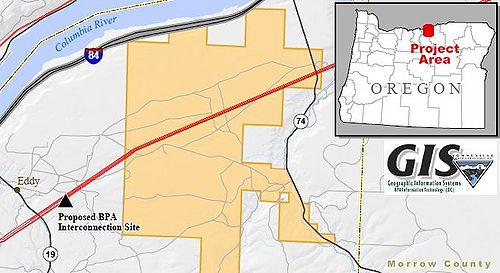
According to The Oregonian[155], green energy subsidies has been treated like a state-sponsored ATM machine.

The Shepherds Flat wind farm[156] (BPA docs[157]), which may be the world's largest wind farm when it's completed in a couple of years, shows how Oregon provides millions of dollars to projects that would probably go forward without state subsidies, says the Oregonian.
The Department of Energy claims subsidies are essential to kick start home-grown sustainable power while the state of Oregon claims large subsidized projects can create a "hub", attracting many smaller supporting industries that will improve our economic outlook. The U.S. DOE announced a $1.3 billion loan guarantee[158], in Dec, 2010, to support Shepard's Flat.
It's a loan from the DOE, not a subsidy. That's an important difference, and never made clear in the Oregonian stories, advocates of wind power[159] point out.
Similar kinds of incentives were made for SoloPower[160], a solar panel startup. That company was granted a $197 million loan guarantee by the DOE[161]. SoloPower will invest up to $340 million and bring as many as 500 jobs and received a $20 million loan from the State, while Solexant will build a $200 million solar module manufacturing plant in Gresham that could one day employ 1,000, and got a $25 million loan from the State.
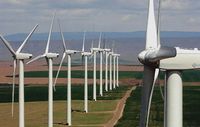
The controversial Business Energy Tax Credit system was overhauled by the Oregon Legislature after it came under fire for the size of the incentives and the management of the program. It lasts until June 2011.
There is no question that the State of Oregon IS helping to fund "green" industries with large tax credits. Opinions differ on the advisability of "green" investments.
It's a bet. Nobody in government, commerce or the news business knows if it will be a good bet.
Coal Fired Power in Oregon
Natural Gas in Oregon
Liquified Natural Gas in Oregon
Fuel Cells in Oregon
Nuclear Power
Bio Mass in Oregon
Co-generation in Oregon
Ethanol and Biodiesel in Oregon
Geothermal Power in Oregon
Green Buildings
Electric Cars in Oregon
Energy Storage in Oregon
Inverters and Electronics in Oregon
Energy Financing
Iberdrola Renewables [162] is the world's largest renewable energy firm. The Spanish multinational is based in Valencia, Spain, with a headquarters office in Portland. It's the world's largest owner-operator of wind farms and operates solar, hydro, biomass and wave power businesses. Iberdrola Renovables[163] has 41 wind farms in the United States with an installed capacity of 3,877 megwatts[164], enough to power close to 1 million average U.S. households.
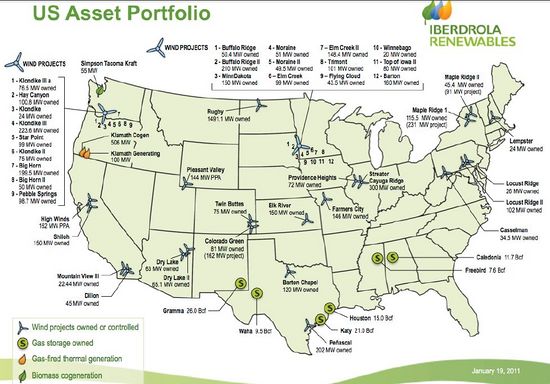
Element Power, a developer of large-scale wind and solar projects, oversees nearly 7,800 megawatts of wind energy and more than 1,700 megawatts of solar power. The company’s Portland-based North American headquarters are overseeing the wind projects and solar that are predominately located in the United States. Element Power is owned by Hudson Clean Energy Partners, a N.J.-based private equity fund created in 2007 by the team that ran Goldman Sachs’ clean energy investment group. They turned Houston-based Horizon Wind Energy into the third-largest renewable energy company in the U.S. The company hopes to employ 50 workers with a payroll of up to $8 million.
The Oregon Department of Energy has released information about the 2011 application process for the Business Energy Tax Credit. Applications for the next round of "Tier 1" credits opens Jan 3, 2011. For this category, there is $15 million in tax credits available for projects with an estimated cost of less than $500,000.
SolarCity's financing options let homeowners and businesses in Beaverton, for example, switch to solar power with little or no up-front investment; power is sold directly to the utility.
SolarCity expanded its presence in Oregon, offering a lease program to customers of Portland General Electric and Pacific Power. It virtually eliminate upfront costs, allowing homeowners to get rooftop solar panels for as little as $20 per month. The new rules allow customers who choose to lease their solar systems to receive the residential tax credit (RETC) that was previously only available to customers that purchased solar systems. SolarCity then sells the "green" power directly to power companies. The Oregon DOE has details.
A new report from the National Renewable Energy Laboratory (NREL) examines feed-in tariffs (FITs). The policy is known for spurring dramatic growth of renewable energy in Europe during the past decade.
Terry Gross explains Cap and Trade, which allows businesses that go over their carbon "budget" to buy "credits" from business who use less then their allowance of "carbon offsets".
Beaverton's 1000 watt array illustrates how to figure your typical power generation, then compare it with your power bill and total solar installation costs. Grape Solar’s kits retail for 25-30K and provide all the power for an average middle-class home. They're out of Eugene. Without subsidies, which can amount to 75% of the cost, solar has a ways to go to reach parity in the home.
The Treasury Grant Program (TGP) for renewable energy projects was passed in mid December 2010. It extends the cash payment of up to 30% of equipment costs in place of the Investment Tax Credit. The grant program was responsible for a large portion of the renewable energy projects built throughout the U.S. in 2010. Originally passed as part of the 2009 stimulus package, it was supposed to expire at the end of December.
The American Wind Energy Association projected a loss of tens of thousands of wind jobs in 2011 without an extension of the TGP while the Solar Energy Industries Association said the grant program spurred over 1,100 solar projects and $18 billion dollars of investment in 2010.
The Smart Grid
The Smart Grid is an enhancement to the power grid that delivers electricity from suppliers to consumers using two-way communications to control appliances. When power is least expensive the user can allow the smart grid to turn on selected appliances. A Home Area Network ties into the "smart meter", using powerline or RF standards such as ZigBee, INSTEON, Zwave, WiFi and others.
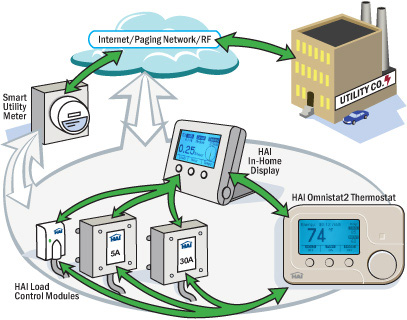
The $178 million Pacific Northwest Smart Grid Demonstration Project is one of 16 regional smart grid demonstration awards announced by DOE in the fall of 2010. It contains key functions of the future smart grid. The project team will install equipment and technology now through mid-2012. Then, for about the next two years, project leaders will gather data on smart grid performance.
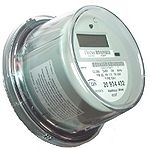
PGE’s new system is a two-way wireless fixed network. It features 46 collectors positioned throughout a 4,000-square-mile service territory. By September, 2010, PGE had rolled nearly 700,000 meters for automated reading. PGE's advanced metering infrastructure, was purchased from Sensus Metering.
According to Venture Beat, there's a battle of standards between companies such as SmartSynch, promoting public network communications, and those endorsing private networks, such as Trilliant and Silver Spring to connect the Smart meter to the power company. There's also a battle of standards to connect devices inside the home.
The Smart Grid Interoperability Panel, a public-private group, has voted for a new standard for two-way data communications between utilities and their customers, recently, bringing the next-generation "smart" electrical power grid a step closer to reality.
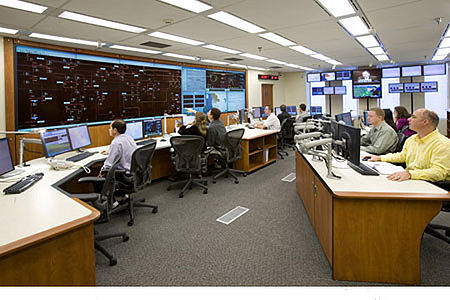
The Pacific Northwest National Laboratory, near Richland, will manage PGE's "Smart Meter" project at their Electricity Infrastructure Operation Center. A smart electrical power grid could decrease annual electric energy use and utility sector carbon emissions at least 12 percent by 2030, according to a report from PNNL.
Smart Grid Oregon is a trade association that promotes the smart grid industry and infrastructure in Oregon.
Solar Projects
Portland's Climate Action Plan includes a directive to purchase or generate 100 percent of electricity for city operations from renewable sources, with at least 15 percent of that generated on-site or in-district using renewable energy sources such as solar and bio gas.
The City of Portland’s Solar America Cities project will pursue solar market transformation for Portland residents, businesses, and city operations. Project partners work with other city bureaus to streamline city-level regulations for contractors, homeowners, and businesses. The city will use its influence as a regulator, educator, and motivator to reach the larger regional community.
Portland has partnered with Solar America Communities and started their own, “Solar Now!” organization. People in the community are volunteering their time to help bring solar into as many homes as possible. Solarize Portland provides information to Portland residents on who to hire, what to buy, and what to budget.
Portland Water Bureau Meter Shop has a 12 KW solar array, the largest system entirely owned by the City of Portland. Portland’s solar-powered parking meters were supposed to lower maintenance costs of jammed coin operated meters while maximizing income. Solar panels were installed on the south façade and roof of Brewery Blocks Building #4 in Portland's Pearl District.
Vernier Software produces 19,000 KW hours each year and helps to educate the community about solar energy through their website www.vernier.com/solar. Lucky Labrador Brewing installed solar panels to heat the water during the brewing process for a total cost of $4,460 after all of the tax credits. Now they have broken even with their install costs and are saving an additional $1,560 per year in gas costs.
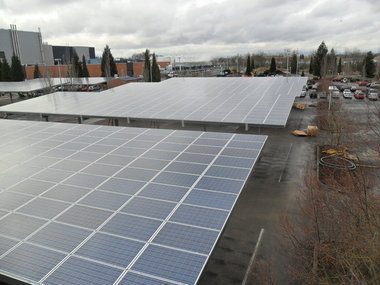
Intel has three, 400 kilowatt solar arrays in Hillsboro. Already the nation's largest buyer of green power, Intel plans to buy 2.5 billion kilowatt hours of renewable energy credits this year, a 75 percent increase over 2010. Intel last year completed eight solar energy projects at its plants in four states. Among them were two 400-kilowatt systems atop raised support structures within the parking lots of its Jones Farm and Ronler Acres campuses in Hillsboro.
What Can I Do to support sustainability?
We can simply waste less. Poor insulation, inefficient appliances and wasteful habits send lots of energy up the chimney. The desire to buy stuff that doesn't really make us happy, doesn't help. Common sense and passion can go a long way.
There are many positive trends. Solar power is becoming more efficient and localized, buildings are getting greener and more self-sufficient, vehicles are getting electrified and using less fossil fuel, and people are more aware of their impact.
There are as many ways to become engaged as there are people.
More Information
Energy Trust of Oregon provides cash incentives for customers of PGE, Pacific Power, NW Natural and Cascade Natural Gas. The Oregon Department of Energy has more information on sustainable energy programs.
External Links
- 85+ Wind and Solar Energy Companies now in Greater Portland, Ore.
- Portland Tribune: Sustainable Life
- SustainableBusinessOregon.com
- Oregon Energy Links
- Sustainable Business Network of Portland
- TheGreenEconomy.tv
- OBP: Ecotrope
- Portland Tribune: China Connection
- City of Portland Energy Policy
- Solarize Portland
- Portland's Ecoroof Program
- Portland's Solar Energy Program
- Oregon Resources: Green Building
- Green Building Council
- Oregon Geothermal
- Oregon Dept of Energy
- Sustainable Oregon Business
- Energy Trust of Oregon
- PGE's GreenPowerOregon.com
- State Incentives for Alternative Energy
- American Wind Energy Association
- National Renewable Energy Laboratory
- PV Magazine
- PV-Tech News
- DriveOregon.org
- AutoBlog Green
- Oregon's Electric Vehicle Charging Network
- Columbia Gorge Energy Tour (Flickr)
References
- ↑ Portland City Council Supports Oregon Sustainability Center
- ↑ Oregon Sustainability Center
- ↑ ODOE: Renewable Energy.
- ↑ Oregon's Renewable Resource Programs
- ↑ Energy Trust of Oregon
- ↑ Wind power in the United States
- ↑ Solar Power Is Cheaper Than Nuclear for the First Time
- ↑ The U.S. spends about $1 billion a day importing oil, which is now over $100 a barrel
- ↑ according to Energy Secretary Steven Chu
- ↑ The Dalles Dam
- ↑ The Grand Coulee Dam
- ↑ The Pacific DC Intertie
- ↑ Bonneville's grid
- ↑ The main renewable energy industries grew 35% last year
- ↑ Clean Energy Trends
- ↑ Grid parity
- ↑ low-carbon economy
- ↑ Zero carbon emissions globally by 2050
- ↑ PGE
- ↑ hopes to shut down the state's only coal-fired power plant 20 years earlier
- ↑ carbon taxes
- ↑ The 585-megawatt coal fired plant
- ↑ Vestas
- ↑ About 4 percent of PGE's energy comes from wind farms
- ↑ Biglow Canyon Wind Farm
- ↑ Klondike II
- ↑ Vansycle Ridge
- ↑ Stateline Wind Farm
- ↑ along the Columbia River
- ↑ Biglow Canyon Wind Farm
- ↑ Vestas wind turbines
- ↑ The wind farm is located in Wasco County
- ↑ [http://djcoregon.com/news/2010/09/08/pge-completes-bigelow-wind-farm/ The $1 billion project was completed in September, 2010
- ↑ Vestas
- ↑ Here's a video tour
- ↑ at Biglow
- ↑ Sam Churchill's Flickr photo collection
- ↑ Shepherds Flat Wind Farm
- ↑ Caithness Energy
- ↑ Southern California Edison
- ↑ The U.S. Department of Energy finalized a $1.3 billion loan guarantee for the Shepherds Flat wind farm
- ↑ Eastern Oregon wind farms, especially the Summit Ridge wind farm in Wasco County, have now been thrown into doubt
- ↑ Iberdrola Renewables
- ↑ the second largest provider
- ↑ an installed capacity of 3,877 megwatts
- ↑ Klondike Wind Power
- ↑ Bonneville Power Administration
- ↑ Sales of small wind turbines
- ↑ American Wind Energy Association
- ↑ Xzeres
- ↑ Oregon Wind's small vertical Helyx
- ↑ As of November 2010
- ↑ Roscoe Wind Farm
- ↑ Horse Hollow Wind Energy Center
- ↑ Alta Wind Energy Center
- ↑ Gansu Wind Farm
- ↑ grew 67 percent to $6 billion in 2010
- ↑ Solar Energy Industries Association
- ↑ Crystalline silicon panels
- ↑ SolarWorld in Hillsboro, Oregon
- ↑ 90% of the industry today
- ↑ Monocrystalline silicon
- ↑ Crystalline silicon
- ↑ Cadmium Telluride
- ↑ Copper Indium Gallium Selenide
- ↑ Thin-film technology has proved challenging to commercialize
- ↑ Cadmium telluride
- ↑ CIGS
- ↑ Cadmium telluride panel
- ↑ Solexant
- ↑ SoloPower
- ↑ is said to be eyeing Wilsonville for a manufacturing plant
- ↑ represent a huge shift in energy economics
- ↑ SolarWorld
- ↑ its 210,000-square-foot addition
- ↑ SolarWorld will collaborate develop a 11.6-megawatt solar system
- ↑ SANYO Solar
- ↑ opened a monocrystalline growing facility in Salem, Ore
- ↑ Cadmium Telluride developer Solexant
- ↑ plans to build a $200 million solar manufacturing plant in Gresham
- ↑ Solexant's facility in Oregon
- ↑ CdTe
- ↑ the largest nanotechnology manufacturing facility in the world
- ↑ reports Oregon Live
- ↑ CIGs developer SoloPower
- ↑ building a manufacturing plant in Wilsonville
- ↑ could employ 500 people within five years
- ↑ tough but flexible solar panels
- ↑ expansion plans call for three more manufacturing lines
- ↑ Grape Solar
- ↑ it just imports low-cost solar panels from China and re-sells them here
- ↑ Advanced Energy Systems
- ↑ The nation’s first Solar Highway project
- ↑ PGE’s “Oregon Solar Highway”
- ↑ Solar Energy Grid Integration Systems
- ↑ The SuNRISE lab contains $1 million of state-of-the-art equipment to analyze solar cells
- ↑ Solar is cheaper than nuclear energy
- ↑ Duke University
- ↑ around 13.6 GW of PV will be installed this year
- ↑ Microinverters
- ↑ Enphase
- ↑ online monitoring of your installation
- ↑ a 4.81 kW solar array in Portland
- ↑ PV Powered
- ↑ 260kW, 97% efficient
- ↑ Teanaway Solar Reserve
- ↑ a 75-megawatt plant made up of 400,000 photovoltaic panels
- ↑ 4 miles North of Cle Elum, Washington
- ↑ National Renewable Energy Laboratory
- ↑ According to three industry experts
- ↑ But Oregon didn’t make the list
- ↑ The largest solar power installation in the world
- ↑ 48-MW Copper Mountain Solar Facility in Nevada
- ↑ Copper Mountain Solar Facility
- ↑ NRG Energy
- ↑ Agua Caliente solar project
- ↑ approved a thousand-megawatt, $6 billion solar project in California
- ↑ will have to cost $1 per watt says the DOE
- ↑ will get to $2 per watt within the next five years
- ↑ In Germany, the industry boomed after the Renewable Energy Act in 2000
- ↑ Wave Power
- ↑ Wave energy
- ↑ committed $200 million in federal funds toward wave energy technology
- ↑ The nation's first commercial wave-energy farm
- ↑ Ocean Power Technologies
- ↑ to have a capacity of 1.5 megawatts
- ↑ Surfpower
- ↑ an interest in exploring their options in Oregon
- ↑ Oregon Wave Energy Trust
- ↑ Ocean Power Technologies
- ↑ close to getting a license to build a wave energy plant off the coast of Oregon
- ↑ a 150 kW wave energy station
- ↑ A 10-Megawatt OPT power station
- ↑ Ocean Power Technologies has contracted with Oregon Iron Works
- ↑ Columbia Power Technologies
- ↑ the first ocean energy device to produce kilowatt scale electrical energy
- ↑ between one and three miles offshore
- ↑ Grays Harbor Ocean Energy
- ↑ is currently a hotly debated topic
- ↑ The trick is to tap the benefits of a new industry without spoiling ocean habitats, economic livelihoods and recreational playgrounds
- ↑ Off shore energy policy
- ↑ No state agency in the U.S has ever permitted a wave energy project
- ↑ Finavera
- ↑ Aquamarine
- ↑ Wave Energy A/S
- ↑ a possible Texas-based
- ↑ Neptune Wave Power
- ↑ Northwest National Marine Renewable Energy Center
- ↑ tidal energy
- ↑ National Renewable Energy Laboratory
- ↑ Oregon Wave Energy Trust
- ↑ Pacific Energy Ventures
- ↑ Oregon Wave Trust
- ↑ the huge Shepherds Flat wind farm raises big questions about state, federal subsidies
- ↑ The Oregonian on Wind Subsidies
- ↑ Shepherds Flat wind farm
- ↑ BPA docs
- ↑ The U.S. DOE announced a $1.3 billion loan guarantee
- ↑ advocates of wind power
- ↑ SoloPower
- ↑ a $197 million loan guarantee by the DOE
- ↑ Iberdrola Renewables
- ↑ [1]
- ↑ an installed capacity of 3,877 megwatts